Nvidia GeForce GTX 1060 6GB Review
Power Consumption Results
Measurement Methodology & Graphical Illustration
Based on reader and vendor feedback, we recently updated how we’re presenting this part of the review, adding a low-pass filter at the maximum sampling rate to minimize aliasing effects and noise.
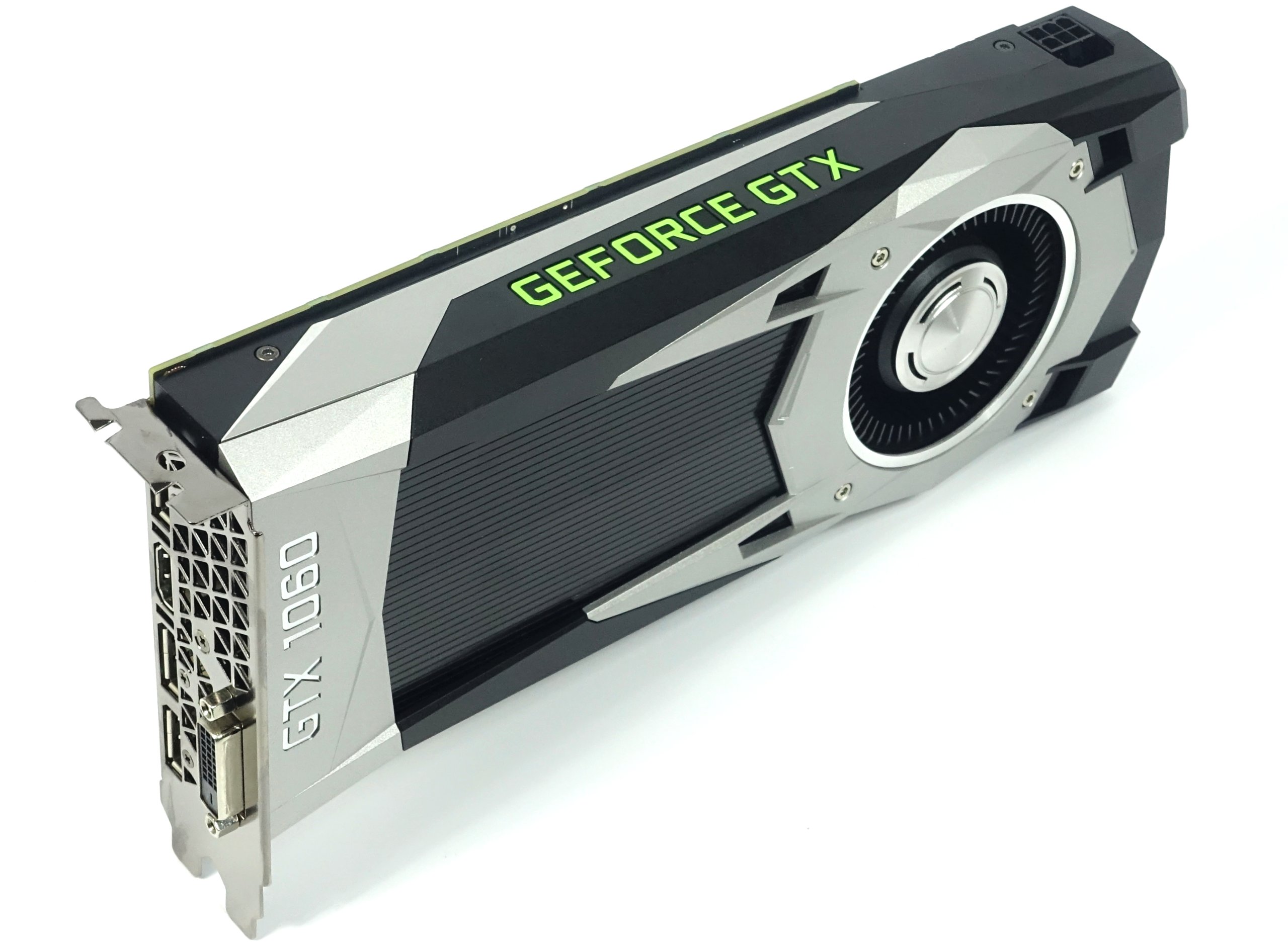
To make understanding the graphs easier, we also increased the measurement intervals significantly and are using a new analysis software package that evaluates the points in time when brief load fluctuations occur, gauging their plausibility. The resulting curves are a lot smoother than the old ones; we hope you derive more value from them as a result.
Power consumption is measured according to the processes outlined in The Math Behind GPU Power Consumption And PSUs.
You'll find a larger number of bar graphs and higher-resolution versions of our power consumption charts that you can expand by clicking on them. Finally, in addition to measuring power consumption, we also take current readings to determine whether our subject adheres to the applicable technical specifications.
Our test equipment hasn't changed from previous articles, though.
| Power Consumption | |
| Test Method | Contact-free DC Measurement at PCIe Slot (Using a Riser Card) Contact-free DC Measurement at External Auxiliary Power Supply Cable Direct Voltage Measurement at Power Supply |
| Test Equipment | 2 x Rohde & Schwarz HMO 3054, 500 MHz Digital Multi-Channel Oscilloscope with Storage Function 4 x Rohde & Schwarz HZO50 Current Probe (1mA to 30A, 100 kHz, DC) 4 x Rohde & Schwarz HZ355 (10:1 Probes, 500 MHz) 1 x Rohde & Schwarz HMC 8012 Digital Multimeter with Storage Function 1 x Optris PI640 80 Hz Infrared Camera + PI Connect |
Power Consumption at Different Loads
You'll notice that we added the average gaming power consumption at different resolutions, which is a different way of looking at things. It’s based on a 170-second and highly varied Metro: Last Light scene (High preset, Tessellation set to Normal, SSAO Off). We'll discuss it in more detail when we get to the efficiency-oriented tests.
For now, the gray bar represents the peak power consumption based on those load peaks that made it through to the smoother curve, in spite of our best efforts (which we described above). Fundamentally, that bar doesn't have any practical significance, since the duration of those peaks is too brief for them to matter.
Stay On the Cutting Edge: Get the Tom's Hardware Newsletter
Get Tom's Hardware's best news and in-depth reviews, straight to your inbox.
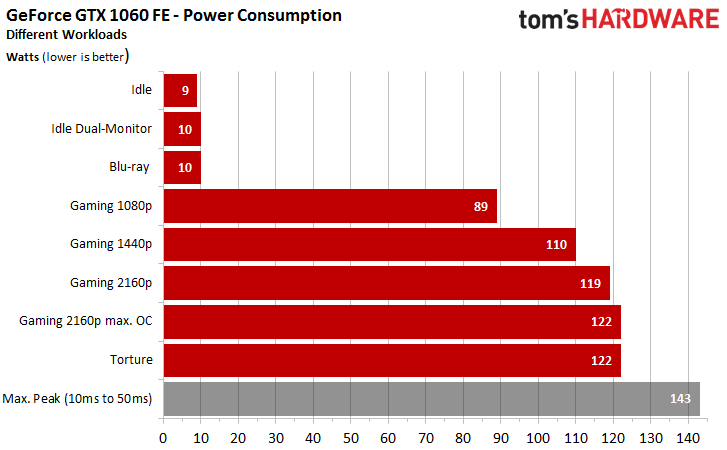
Power Connector Load Distribution
Now we're getting into the nitty gritty. Measurements across the different rails during our taxing gaming and stress tests show that Nvidia manages to distribute the load well with a bias to the six-pin power connector. The 3.3V rail isn't used anymore, which is why you won't find it in our charts.

Here are the detailed graphs. Clicking on them brings up the high-resolution versions.
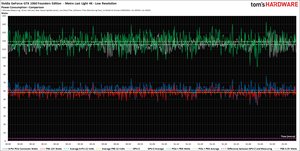
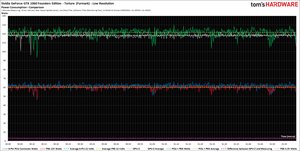
The PCI-SIG’s technical specifications cover current exclusively, so that’s what’s shown in the chart below (power consumption only tells half of the story, after all). With less than 5A for the motherboard slot, Nvidia plays it safe with its GeForce GTX 1060. The maximum, according to the PCI-SIG, is 5.5A.
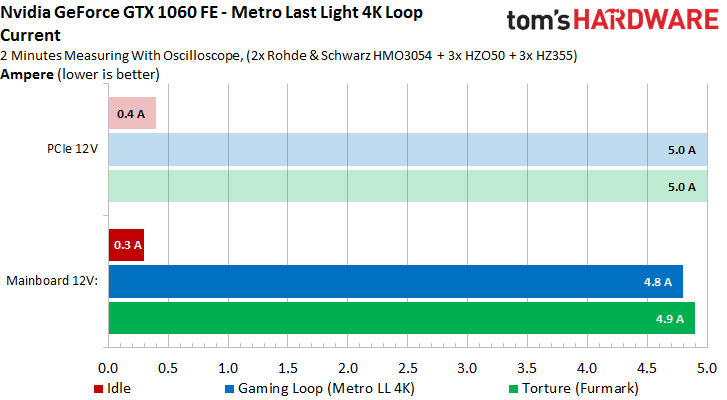
We have detailed graphs for the current measurements as well. Once again, clicking on them brings up the high-resolution versions.

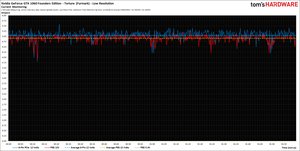
Power Consumption Comparison with Other Graphics Cards
Now we can look at how Nvidia's GeForce GTX 1060 stacks up against the competition. We’re using the peak power consumption results, since they're comparable to the results obtained with our older testing methodology.

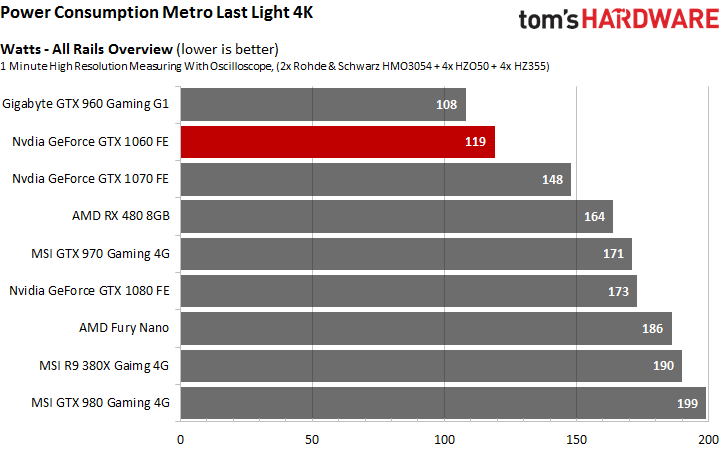
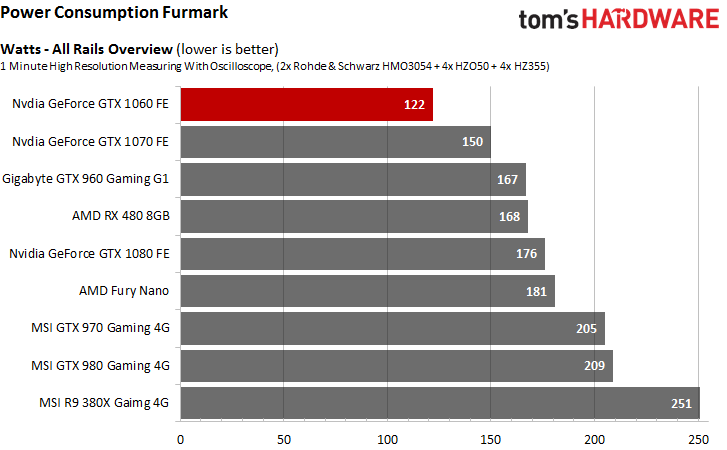
The GeForce GTX 1060 registers slightly higher consumption than the GTX 960 in our gaming benchmark. However, its lower power target changes that situation during the stress test. No matter how you slice it, Nvidia's GeForce GTX 1060 is the fastest graphics card in its 120W segment.
MORE: Best Graphics Cards
MORE: Desktop GPU Performance Hierarchy Table
MORE: All Graphics Content
Current page: Power Consumption Results
Prev Page Rise of the Tomb Raider, The Division & The Witcher 3 Next Page Efficiency & Over/Underclocking Results-
Vosgy Well with it's price point above the 480 and performance performance difference relatively matching the price difference seems like it will come down to what someone can afford at the time.Reply
Guess I'll recommend either from now on.
Thanks for the review guys, pleasure as always :D -
mitch074 I wonder: with Battlefield 4, why not add the Mantle-enabled rendering path? All existing tests show it to be pretty much equivalent to DX12, and future high-performance, low-latency titles are much more likely to make use of DX12, Vulkan etc. than DX11 or OpenGL...Reply
On that review, as a matter of fact, you use pretty much only DX11 games and only one DX12 title; new API paths are available in Dota2, Talos Principle and Doom 2016... Why not include them, as a reference for the future of gaming, instead of only showing off DX11 games? -
LFCavalcanti You could have included in the value discussion the question about having 2 RX480 in Crossfire vs a single 1070, sort off denying a market place in value for the 1060.Reply
I don't know what NVidia is thinking... their marketing campaign might be stronger than I understand and people will still buy the 1060, but value on it just don't make sense right now. -
BrutalPigeon Where are DX12 reviews? Hitman DX12? Time Spy? 1060 gets rekt in DX12. Nvidia biased review again, also project Cars? How is this even a benchmark, obviously gimped for Radeons.Reply -
kicsako This review is kinda strange. You use Project Cars what is known of running so bad on AMD cards, yet there are no dx/vulkan 12 titles except AOTS. We already have Doom(Vulkan), and Total War+Hitman for dx12. This review is weirdly Nvidia biased. People who buy mid lvl cards are not going to change it for at least 2-3 years. And we will see more and more dx12/vulkan titles yet you only include dx11 games with mostly Nvidia support. Never gona read tomshardware ever again.Reply -
Myrmidonas Yes indeed. I read elsewhere on DX12 benchmarks GTX 1060 does not cope well against rx480. Also, why not DOOM?Reply
Long story short, if you have Win7 and don't plan to upgrade for the next 2-3 years you have a solid reason to get a GTX 1060. The "plot changes" in favor of RX480 if you are going all forward with Win10. -
logainofhades No SLI, on a card of this caliber. Quite the disappointment. Doesn't appear that it quite met the hype. Solid card, at its price point, but still not quite what was expected.Reply -
IceMyth What I understood from this review is either get 1070 or 1080 or RX 480... the 1060 is a waste of money and time since you cant SLI so what you will get will be fixed and to get better gaming you will need to replace the whole GPU to one of the 3 top.Reply
Honestly I expected something decent but seems they released a cheap GPU for NVidia fans rather than to compete with AMD performance and prices! -
AndrewJacksonZA Thank you for the review Chris! It was a pleasure to read high-quality writing with good English - my brain really thanks you! :-)Reply
I would also like to join others in their request for:
- including 2x RX480s in Crossfire (price-wise they are comparable to a 1070,)
- a benchmark using Doom's Vulkan rendering path, and
- results from the TimeSpy benchmark please.
Thank you again for a relaxing and informative read,
Andrew -
cknobman I'd say typical Nvidia cash grab.Reply
A. Card is priced about $50 too high as review kind of indicates.
B. SLI is removed because Nvidia wants you to spend more $$$$$$$ on their higher priced cards. They dont want people trying to achieve playable 4k resolution without paying that Nvidia premium tax.
Right now if I was buying to play 1080-1440 I'd go AMD 480 all the way.
